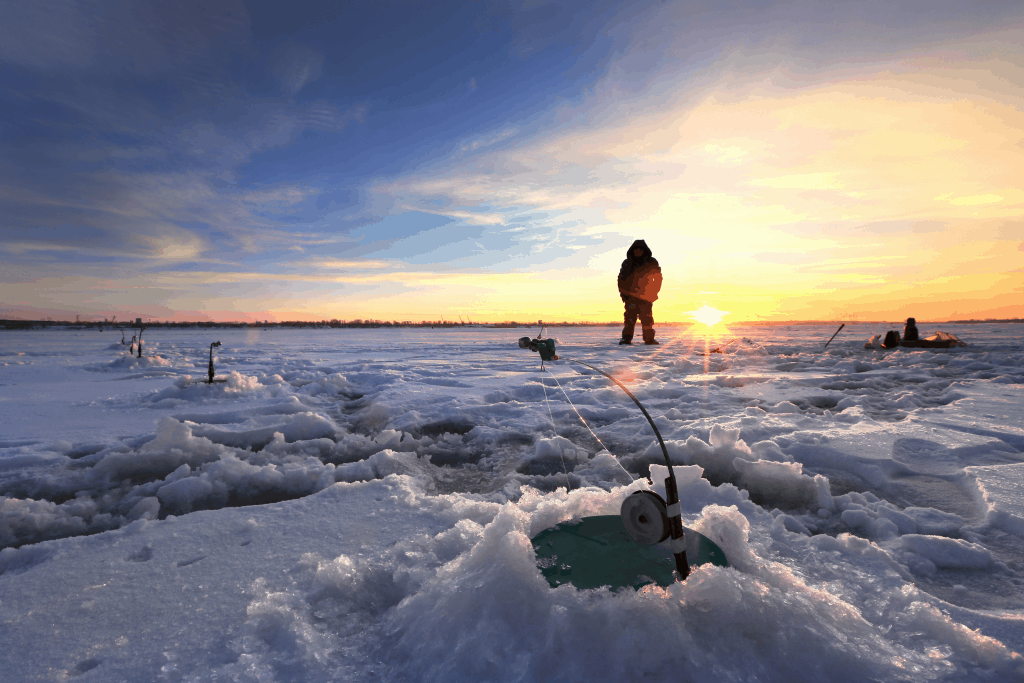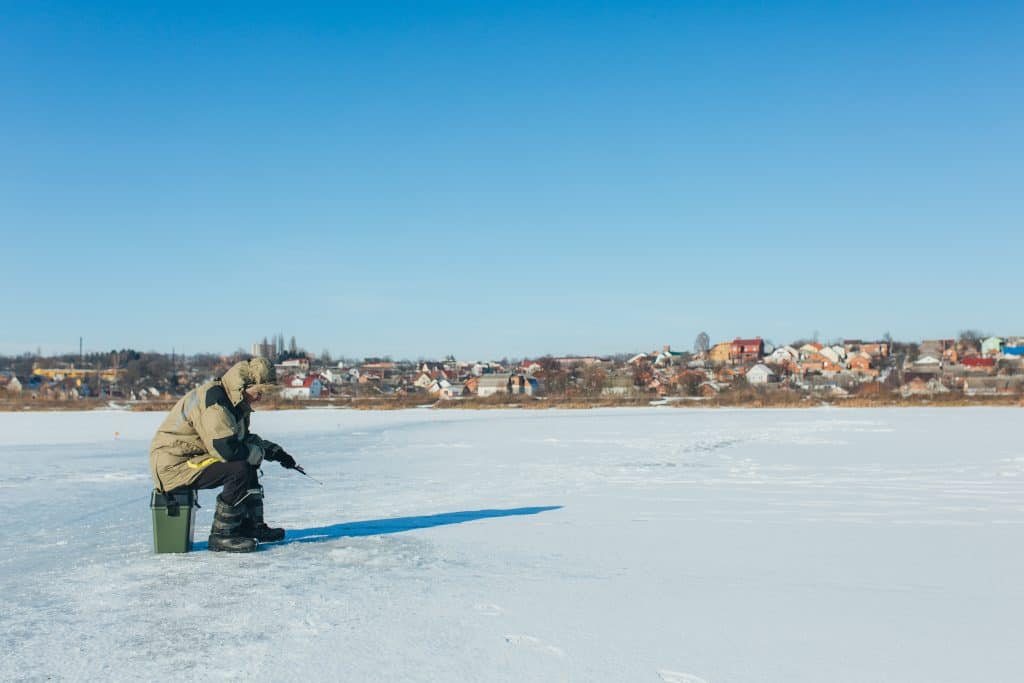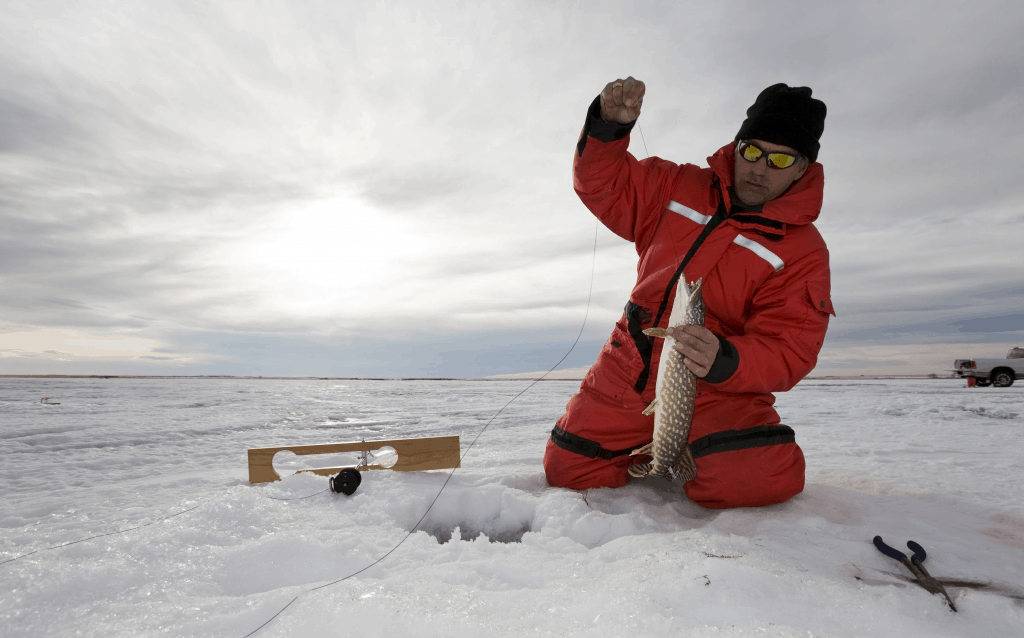When you go ice fishing, you might not be sure how deep underwater you should drop your line. So, I’m going to give some advice on that, and how different depths can affect what fish you catch.
It is generally recommended that the bait be lowered to within 3-4 feet of the bottom of the lake when ice fishing. While there are certainly exceptions, fish usually stay near the bottom during the winter.
However, this will not be the only way you catch fish under the ice. For a number of reasons, you may have success at other depths as well, especially if things seem slow at the bottom. The type of fish you are looking for will affect your decision as well.

Tips for Fishing at the Bottom
One of the beauties of ice fishing is the ability to go on foot where normally only a boat could take you. So why not head to the middle of the lake and drop your line all the way to the bottom?
You are likely to have a lot of success doing this. It will take some planning, though.
If you’re aiming for the bottom of the lake, this could mean over a hundred feet deep. For that reason, you are going to need a lot of fishing line to do this. The surefire way to know how much you need is to find out how deep the lake is. A topographical map can tell you this.
If you are using tip-ups, you will want to fill each one with at least 100 feet of braided line (this kind of line is easiest to deal with in the winter), and if the lake is particularly deep, you’ll need even more.
If you are using a fishing rod, you should have at least 100 yards on the reel.
Now when lowering your line to the bottom of the lake, it is risky to bring it all the way to the floor, because there may be vegetation and logs there that will get your line stuck, and that’s a pain to deal with. Or, your bait could simply get lost in the mud or become too hard for this fish to even find.
However, some fishermen, such as one on lake-link.com, do find letting your jig bounce off the floor of the lake to be a great trick for catching large perch and bluegill.
The reason is that this bounce will create a cloud of debris which will attract these fish. A fish might not notice some bait just sitting there, but if it sees a cloud of dirt, it’s going to get curious and go see if it’s something it can eat.
Another trick you could try is to just let your jig just rest at the bottom. It should just barely rest there. Use a spring bobber to help you fish like this. It will go up when a fish takes the bait. Fish are more lethargic in winter, so at certain times, they may be happy to see what looks like motionless food.
Knowing whether it is wise to try these techniques can be a little tricky, because, again, it would be a pain to just have your line get stuck in the weeds or lose your bait under some rocks, or in a hole. A good fish finder could help you determine what’s down there, though.
Local fishermen, such as people working at a nearby fishing store, might know a thing or two about whether this is a good idea or not. They will know plenty of other great tips for the area too, by the way.
If you choose to avoid touching the bottom, which is definitely a good and safe option too, as it avoids the risk of your bait getting lost or stuck, just have your lure hover a little bit above it, about 2 feet.

The fish you will find by going deep underwater are called bottom-feeders, and species include lake trout, catfish, perch, and others. The name “bottom-feeders” is pretty self-explanatory: they hang out near the bottom of the lake.
These fish are not picky eaters. If it looks like food, they will eat it, dead or alive. So, you have plenty of options. You can use raw meat if you want to.
Keep the bait moving to help fish see it. Fish will be on the move, so a moving object is likely to attract them.
You will be able to catch a lot of big fish by going deep underwater. It’s a great strategy that should prove successful.
Try Shallow Depths
Lowering your line to the bottom of the lake is certainly not the only strategy, however, and you shouldn’t feel limited to it.
You can also ice fish in middle depths. Or, you can just go for fish swimming near the surface.
For either of these depths, of course, you don’t necessarily need as much fishing line as you would going all the way to the bottom. However, it is wise to keep a lot of line on you anyway. As I said before, when using a pole, you should have 100 yards on your reel. And for tip-ups, 100 feet is a good guideline as well.
By “middle,” I mean more than 10 feet underwater, but obviously not too close to the bottom like I discussed earlier. It’s possible to get tons of action in this zone.
In the middle section, it’s possible to find literally any of the species of fish I have mentioned so far, as well as ones that you will also find closer to the surface, such as trout, salmon, pike, and muskies. You may also find bluegills and probably others.
Fish will go wherever food is, so there is no guarantee that they will stay in one spot. Where they are can just depend on the day and time of year.
For example, perch tend to travel in groups. If you catch one at the bottom, there is a chance that you will not need to lower your line all the way down again, because the group it was traveling with may have swum up, looking for more of that tasty bait you dropped. So it’s not unlikely that you will find them in the middle section.
When going for mid-range fish, you want to get their attention. So use bright, colorful bait. Or use jigged lures. You want the bait to be able to be seen from a distance, particularly in muggy water.
As for the shallow waters (up to 10 feet below the ice), there are plenty of fish hanging out there, looking for food. These fish will love to eat insects, shiners and forage fish. Use 2 or 3-inch minnows or shiners.
As with the mid-level section, the fish here are going to be attracted by obvious, brightly-colored bait. And once again, you can use a colorful jig instead of bait if you want. By doing this, you may be able to entice fish swimming a bit lower to go upward and take your bait. Then it’s a quick trip for them to the surface.
The best time to go shallow is in the early morning or late afternoon. This is when the greatest number of fish will be in these waters, searching for food.
Surprisingly, I actually found an academic study about fish in the winter that showed that fish tended to be below ten feet underwater at times other than these. So, this advice is backed by science.
With that said, bright bait can be effective at any time of day. Early mornings and late afternoons/evenings though, may just give you easy pickings.

Species you will commonly find near the surface include trout, salmon, pike, muskies, and pickerels. If these species are what you’re after, definitely go for the top or middle section. It is always wise to research tips on how to catch specific species, of course, if you know exactly what you are looking for.
Whether you try for the middle level or the top, you should be able to find plenty of fish underneath the ice in these depths. And if those don’t work, try the bottom again.
Keep Experimenting with Depths
The smartest thing to do is to not just stick with one depth. While I believe the bottom level is an optimal strategy to start with, on some days, other levels will simply give more success. It varies per location, time, and month.
Dealing with this fact is where tip-ups really come in handy. If you don’t know, tip-ups are used to suspend bait below the water, and when fish bite, a flag pops out letting you know. An ice fisherman using tip-ups can have lines in many different holes, not just one.
A great strategy recommended by gameandfishmag.com is to dig several holes, place tip-ups with bait on the lines in all of them except one, which you reserve specifically for jigging, experimenting with depths.
When you notice success with one particular depth, you can adjust all your tip-ups to target that depth. This is a very efficient way to ice fish!
Yes, using one hole to jig is certainly a way to keep yourself busy if you don’t want to just sit around waiting for tip-ups to go off. You might appreciate the warmth that being a bit active will provide, too.
But more importantly, by experimenting with different depths through your jigging, you can catch a lot more fish. For example, if you start jigging at the middle level of the lake, and find yourself suddenly catching tons of fish, you will want to go to each one of your tip-ups and adjust them so the line sits at the middle level.
If you do that, you might find that your tip-ups start going off so often you can barely keep up with them. There’s no real point in experimenting anymore with your jigging if that happens, of course. And if you want physical activity, you’ll get quite a lot running from hole to hole bringing up fish. It will be a glorious haul.
Now, if you don’t have any tip-ups, there is no way you will get as efficient as what I just described because you will be more limited in how many lines you can monitor. However, hopefully, you will still be able to find the most productive depth.
Once again, if it’s close to dawn or dusk, fish are likely to be closer to the surface. If that’s when you’re fishing, definitely feel free to leave your bait in the shallow or middle waters.
Anytime after mid-morning and before the late afternoon, I definitely recommend lowering the line deep underwater. Still, this is not an exact science, so if you are using the correct kind of bait for what you are hoping to catch and still aren’t getting anything, simply try raising the line.
Use a Fish Finder
A way to make this far easier, to an extent where it could almost feel like cheating to those who like things more old-fashioned, is to get all techy and use a fish finder. A fish finder, simply put, is a little computer that will use sensors to determine the depth of the lake and detect objects down there.
Don’t get your hopes up too high, though: using a fish finder isn’t going to be as easy as the device telling you where exactly to drop your line and exactly how deep for a guaranteed catch. But it should give you a decent picture of where the fish are hiding, and how deep.
Some fish finders are designed to go on your line, and so those may give you an especially clear picture at what’s underwater, and whether there are many fishes hiding deep in the lake or not.
So, a fish finder is definitely one way to figure out which depth may produce the most catches. You will probably want to check on it periodically; even if one depth is resulting in good success, the device may indicate that even more success could be awaiting elsewhere.
Ask the Locals
If you want even more knowledge about how deep to drop your line aside from just experimenting, it’s definitely a good idea to ask local experts. Where would you find those? They could be at the lake with you if you’re lucky. If you approach them in a friendly manner, they’ll probably be willing to offer their two cents.
Or, as I mentioned earlier, if there is a fishing store near the location where you plan to go fishing, the owners most likely do a fair bit of fishing themselves, including ice fishing. Feel free to ask them about depth (and any other topics you want to know about). Opinions may vary, but it never hurts to get an enthusiasts’ opinion.
Also, when deciding which depth to choose, consider which types of fish you are looking for. I have listed where to find several different species already, but there are plenty of others. Do a bit of research if there is a specific kind of fish you want, and you will know whether they prefer deep or shallow water.
The question of how deep to lower your line when ice fishing is one that doesn’t have an answer that’s true 100% of the time. So feel free to try different things.
And definitely consider getting tip-ups, because they are the most efficient way to figure out where the sweet spot is.
